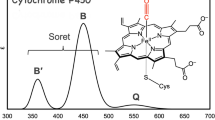Abstract
To test the feasibility of local spin theory of Davidson and Clark for ferrodoxin clusters, the models [Fe2S2(SR)4]2− (R=—H, —CH3) are chosen for evaluation. This purpose is realized by calculating the local spin expectation values 〈S A·S B〉, 〈S 2A 〉, and m A and discussing the connection between these expected values and the Heisenberg spin model (HSM) and the Noodleman broken-symmetry approach. In practical calculation, the spin-unrestricted Hartree-Fock (UHF) and spin-polarized density functional theory (DFT) are used and the calculational qualities of these two methods are also discussed. In addition, the theoretical magnetic coupling constants J AB of these models are calculated by various computational schemes for comparison with both theoretical and experimental results previously reported.
Similar content being viewed by others
References
You X Z. Molecular-based Materials-Opto-electronic Functional Compounds (in Chinese). Shanhai: Shanghai Sci&Tech Press, 2001. 122
Ren J, Chen Z D. Progress in quantum chemistry studies on molecular magnetism. Chinese Journal of Inorganic Chemistry (in Chinese), 2002, 18(8): 753–760
Kahn O. Molecular Magnetism. New York: VCH Publishers, 1993. 4884
Noodleman L. Valence bond description of antiferromagnetic coupling in transition metal dimmers. J Chem Phys, 1981, 74(10): 5737–5743
Noodleman L, Baerends E J. Electronic structure, magnetic properties, ESR, and optical spectra for 2-Fe ferrodoxin models by LCAO-Xα valence bond theory. J Am Chem Soc, 1984, 106(8):2316–2327
Noodleman L, Davidson E R. Ligand spin polarization and antiferromagnetic coupling in transition metal dimmers. Chem Phys, 1986, 109(1): 131–143
Noodleman L, Case D A, Aizman A. Broken symmetry analysis of spin coupling in iron-sulfur clusters. J Am Chem Soc, 1988, 110(4):1001–1005
Ren J, Chen Z D. Application of density functional theory in molecular magnetism 1. Magnetic coupling interaction in oxo-bridged iron (III) Dimer [Cl3FeOFeCl3]2−. Acta Chimica Sinica (in Chinese), 2003, 61(10): 1537–1542
Chen Z D, Xu Z T, Zhang L, Yan F, Lin Z Y. Magnetic exchange interaction in oxo-bridged diiron(III) systems: density functional calculations coupling the broken symmetry approach. J Phys Chem A, 2001, 105(42): 9710–9716
Soda T, Kitagawa Y, Onishi T, Takano Y, Shigeta Y, Nagao H, Yoshioka Y, Yamaguhci K. Ab initio computations of effective exchange integrals for H-H, H-He-H and Mn2O2 complex: comparison of broken-symmetry approaches. Chem Phys Lett, 2000, 319(3–4): 223–230
Cory M G, Stavrev K K, Zerner M C. An examination of the electronic structure and spectroscopy of high-and low-spin model ferredoxin via several SCF and CI techniques. Inter J Quantum Chem, 1997, 63(3): 781–795
Liu C B, Hu H Q, Yang X H. A practicable parameter describing magnetic interactions. Chem Phys Lett, 2001, 349(1–2): 89–94
Li J. Calculation of iron-sulfur clusters in FeS protein active sites by broken symmetry density functional method. Acta Chimica Sinica (in Chinese), 2000, 58(12): 1529–1533
Mouesca J M, Chen J L, Noodleman L, Bashford D, Case D A. Density functional/Poisson-Boltzmann calculations of redox potentials for iron-sulfur clusters, J Am Chem Soc, 1994, 116(26): 11898–11914
Clark A E, Davidson E R. Local spin. J Chem Phys, 2001, 115(16): 7382–7392
Davidson E R, Clark A E. Local spin II. Molecular Phys, 2002, 100(3): 373–383
Clark A E, Davidson E R. Local spin III. J Phys Chem A, 2002, 106(29): 6890–6896
Clark A E, Davidson E R. Model molecular magnets. J Phys Chem A, 2002, 106(32): 7456–7461
O’Brien T A, Davidson E R. Semiempirical local spin: theory and implementation of the ZILSH method for predicting Heisenberg exchange constants of polynuclear transition metal complexes. Inter J Quantum Chem, 2002, 92(3): 294–325
Wei J C, Ju G Z, You X Z. A local spin study for magnetic model complex HHeH. Sci China Ser B-Chem (in Chinese), 2004, 34(3):218–224
Wei J C, Ju G Z, You X Z. Study on magnetic properties for (µ-oxo)bis[trichloroferrate(III)] dimer [Fe2Cl6O]2− by local spin theory. Chem Phys Lett, 2004, 391(4–6): 226–233
Helmut B, Richard H H, Eckard M. Iron-sulfur clusters: Nature’s modular, multipurpose structures. Science, 1997, 277(1): 653–659
Löwdin P O. On the non-orthogonality problem connected with the use of atomic wave functions in the theory of molecules and crystals. J Chem Phys, 1950, 18(3): 365–375
Mayer I. Comments on the quantum theory of valence and bonding: choosing between alternative definitions. Chem Phys Lett, 1984, 110(4): 440–444
Bobrik M A, Hodgson K O, Holm R H. Inorganic derivatives of iron-sulfide-thiolate dimers and tetramers. Structures of tetrachloro-μ-disulfido-diferrate (III) and tetrakis(chloro-μ3-sulfido-iron) dianions. Inorg Chem, 1977, 16(8): 1851–1858
Author information
Authors and Affiliations
Corresponding author
Additional information
Supported by the Doctorial Initial Foundations of Hainan Normal University (Grant No. 13140252)
Rights and permissions
About this article
Cite this article
Wei, J., Wang, Y. & Ju, G. A local spin evaluation into the active site models of [2Fe2S] ferrodoxin [Fe2S2(SR)4]2− (R=—H, —CH3). SCI CHINA SER B 50, 327–334 (2007). https://doi.org/10.1007/s11426-007-0057-1
Received:
Accepted:
Issue Date:
DOI: https://doi.org/10.1007/s11426-007-0057-1




